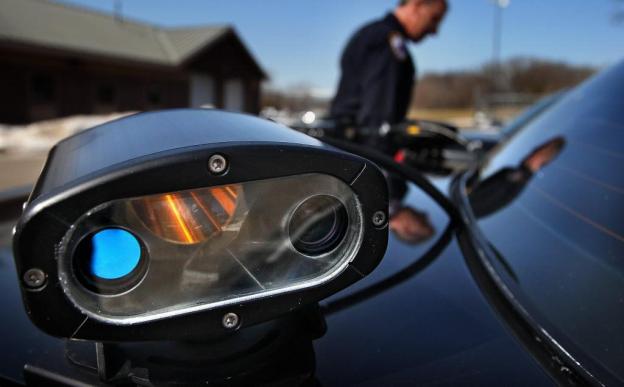
Aha – just because you didn’t think anyone saw you driving to Baskin Robbins for ice cream when dieting doesn’t mean there won’t be record of it indicting you of the heinous crime years from now.
According to a one group, police could be tracking moves as innocent as you sneaking out for that scoop of Chocolate Walnut Ice and storing it in a data base to be used in the future. Are they using an as-yet unknown system of hidden cameras? Not really. It’s all done using an automated technology known as license plate readers.
According to a study released by the ACLU, the widespread use of the location tracking technology using the readers, which Digital Trends reported on in an October story, is much more concerning than first expected when it’s comes to privacy issues.
After analyzing more than 26,000 pages of documents from police departments in cities in 38 states and Washington, D.C., the ACLU is now concerned that the devices are being used for mass surveillance.
The devices in question, officially known as License Plate Recognition systems, or LPRs, use infrared-equipped video cameras and optical character recognition software to read vehicle license plates. the system then sends the data wirelessly to the department’s main computer and checks the plate against an installed database to identify stolen vehicles or individuals driving with a warrant. Some systems check the plate using constantly updated data stored in the patrol car’s computer.
The LPRs are at work scanning plates whenever they are on (which is usually whenever the police car is running and out on patrol) and use invisible infrared light to “see” license plates at night. They can even read dirty plates or plates at an angle from the camera. A single police patrol car equipped with an LPR system can read thousands of license plates per day.
They cameras don’t just read plates of vehicles driving in front of the police car. The system’s multiple cameras read any plate that comes into view around the patrol car, whether the vehicle is moving, parked, or in a driveway visible from the street. If a suspect plate is read, the officers in the car are notified on a computer screen and with an audible signal. Most of the time, the system just ticks away autonomously while the officers focus on other duties.
One of the primary issues, cites the ACLU report, is that virtually all of the data license plate readers gather is about people who haven’t done anything wrong.
For example, in Rhinebeck, NY of the 99,771 plate reads stored from January – March 2102, the law enforcement had a hit record 0.01% of people who actually committed a crime. In Burbank, IL, of the 706,918 plate reads stored from August 2011 – July 2012 the hit rate was 0.3 percent, as indicated on the ACLU’s interactive map, which provides a more detailed breakdown of the numbers.
However, the ACLU report notes that what’s of greater concern is how long law enforcement officials can keep the data on file.
While some law enforcement jurisdictions like the Minnesota State Patrol deletes the data after 48 hours, in Yonkers, NY it’s held indefinitely, according to the ACLU. Only two states, Maine and New Hampshire, rated a positive response when it comes to what becomes of the data.
Whoa? Yeah, exactly.
It’s part of a trend that seems to be growing as law enforcement officials work to beef up their technology in an effort to catch criminals ranging from speeders, car theft suspects and other local scofflaws to potential terrorists. But what happens to that data is a growing concern.
As reported by Digital Trends in this story, some Portland Police patrol cars have become a “TV station on wheels” with vehicles being equipped with no fewer than five digital video cameras, including a 720P camera looking ahead and four tiny GoPro-sized wide-angle cameras covering the sides and back seat – and that’s in addition to the LPR system’s cameras in the car, which can read up to 8,000 license plates a day. Every day.
Portland Police praised the system and said it helps them recover stolen cars much more quickly and could be crucial in cases such as locating a missing child. Law enforcement officials in Oregon have yet to respond to the ACLU’s request for information on how long data collected from license plate readers is kept on file. According to a report posted on a Portland television station’s website, Portland Police say they keep their LPR data on file for four years. In talking with DT, Portland police officials said the system is only doing much more quickly what officers have done for decades: calling in license plates as a routine part of their patrols.
But across the nation, there are no standardized guidelines for law enforcement to either store, disperse or destroy the vast amounts of data they are collecting from LPRs on a daily basis.
The overriding question is, in addition to pinning those ice cream runs on you, what else could the information be used for in the future? The ACLU speculates it might include everything from noting your place of worship to the doctor you visit. In fact, the data could even be used to even identify and document your friends’ movements – irregardless of the fact that you’ve never been suspected of committing a crime.
Are LPR systems benign data funnels that are helping law enforcement catch bad guys? Or could the data they collect, including the location of a certain car at a specific time in a specific place, be used by any number of agencies in the interest of security, say, following a terrorist event?
Consider that as food for thought the next time you get a sudden craving for cookies and cream.
Photo Source: Dallas News
What do you think of license plate readers? Legit crime tool or an opportunity for abuse? Comment below.


